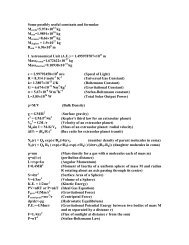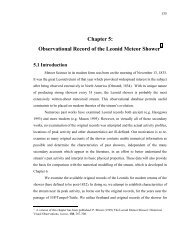Edwards W.N., Brown P.G., Weryk R.J., ReVelle D.O.
Edwards W.N., Brown P.G., Weryk R.J., ReVelle D.O.
Edwards W.N., Brown P.G., Weryk R.J., ReVelle D.O.
Create successful ePaper yourself
Turn your PDF publications into a flip-book with our unique Google optimized e-Paper software.
226 W. N. <strong>Edwards</strong> et al.<br />
Fig. 2 Comparison of cylindrical weak shock theory of meteor generated infrasound (<strong>ReVelle</strong> 1974, 1976)<br />
with the observations of ballistic and quasi-ballistic infrasound at ELFO for those meteors with known<br />
trajectories. (a/b) For an isothermal atmosphere and (c/d) vertically inhomogeneous (layered) atmosphere<br />
Dp’s for isothermal and inhomogeneous models that consistently underestimate and<br />
overestimate, respectively, the observed Dp by at least an order of magnitude, due to the<br />
slower decay of linear waves over weak shocks (x –½ vs. x –’ respectively where x is scaled<br />
distance from the source, R/R o).<br />
We conclude, therefore, that observations of regional meteor infrasound so far recorded<br />
by ELFO are consistent with theory assuming predominantly weakly non-linear shock<br />
waves propagate to the ground. Knowing this we attempt a bottom-up treatment, determining<br />
the mass of each source meteoroid (independent from photometric methods) by<br />
least squares fitting the sum of the residuals between theoretical Dp and period and those<br />
observed, using vertically inhomogeneous cylindrical blast wave theory with the meteoroid<br />
mass as the sole variable (the remaining parameters being constrained by observation). The<br />
resulting infrasonic mass for ballistic and quasi-ballistic observations (Table 1) is found to<br />
relate to the photometric mass roughly as:<br />
123





